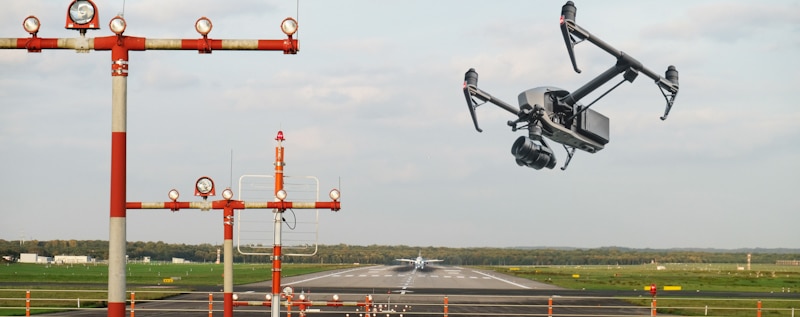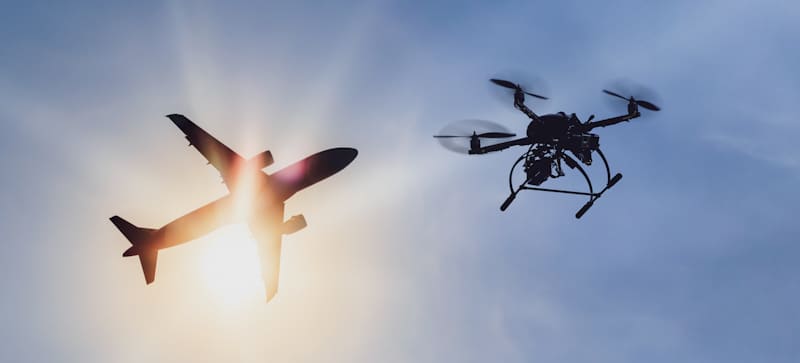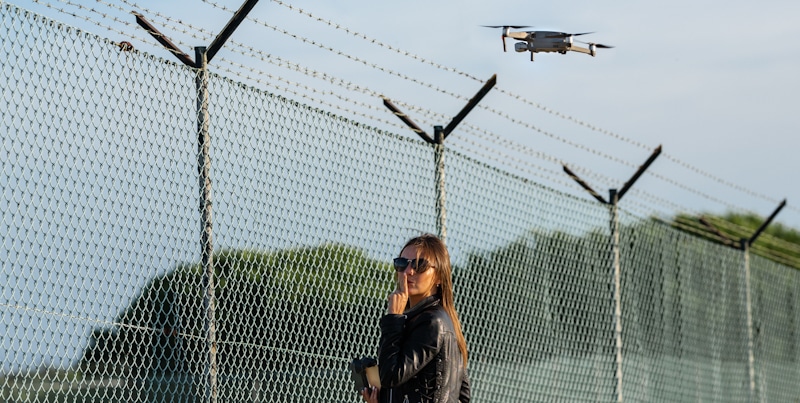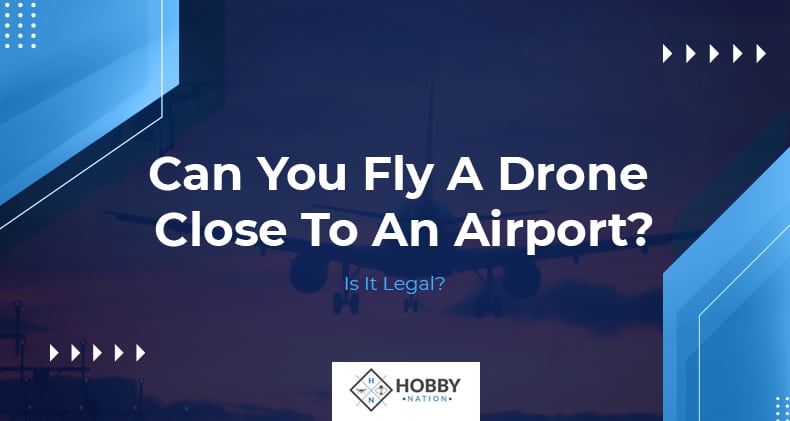Drones are becoming increasingly popular. With growing prevalence, the laws and rules regulating their use in public areas are also getting more stringent. And those guidelines come into play big-time whenever the issue of flying a drone near an airport is brought up.
You cannot legally fly a drone near an airport – at least not within the 5-km (3.1 miles) radius without proper permission. And even if the airport authorities approve the drone use, the authorization will come with several altitude and operational limitations, as there's a lot at stake.
If you'd like to know more on the reasons why a drone is usually not allowed near an airport, what are the likely outcomes of flying an unauthorized drone close to an airport, how to seek permission to fly, and lots more, keep reading.

Why Is A Drone Not Allowed Near An Airport?
When flying in the air, drones are specks that crewed aircraft can find extremely difficult to detect near an airport or in the sky. As a result, it can be almost impossible to steer clear of a flying drone in the air and not crash into it.
Drones impacting normal flight operations is no figment of imagination. The mini aircraft causing interference in crewed flight operations have happened in the past.
And it's not just in the United States. Airports in other parts of the world, including Dubai, London, Dublin, etc., have had their trysts with UAVs. The drones have either delayed or halted flights at these airports, causing tremendous annoyance to the passengers, authorities, and financial losses to airlines.
What Happens If A Drone Comes In Contact With A Moving Airplane?
If a UAV is found in restricted airspace and comes in accidental contact with a human-crewed aircraft, multiple things may occur. The collision's actual damage or its enormity would depend on the drone's mass and the velocity of the impact.
An aircraft component a drone is likely to come in contact with during a crash is the airliner's engine. The pace at which the engine's blades move is more likely to pull in a drone or any flying object, such as a bird. Small drones get easily diced up by an airliner's engine. But as drones get bigger, things become a bit more challenging to manage.
The drone's density, the angle at which it hits the airplane, its frangibility (whether it shatters into tiny pieces or deforms upon impact), etc., also have a say in what transpires. Though multiple things determine the outcome, the real damage is likely if the drone hits the aircraft at a 90° angle. What part of the airplane does the drone hit also matters.
A Flying Drone’s Impact On Different Airplane Components
Airplane engines are usually factory-designed to endure stray object damage to a certain extent, and the fragments approaching them at high speeds would likely get contained inside the engine. This protection, however, is not for sure. The stray items mentioned above do not necessarily imply drones, particularly not the larger ones. Modern engines aren't devised to guzzle drones in with the ease with which they gobble up birds.
And it's not just the engine that's vulnerable. A drone could hit any other part of an airplane, leading to issues of its own. The windshield, for instance, may not get damaged too much by an approaching drone. But the radome could be at risk. A radome is a weatherproof, structural enclosure that safeguards a radar antenna.
A helicopter or a light aircraft, on the other hand, has more reasons to be scared of drones. Compared to regular airplanes, their windshields aren't as robust and are pretty likely to get damaged. Moreover, a helicopter usually doesn't fly as high as a traditional aircraft. It's likely to fly much nearer to a drone or at a similar altitude, heightening its risk of being involved in drone-related accidents.
Drones Are Not The Same As Birds
To people unaware, a drone coming in contact with an airplane may not seem a lot different from a bird hitting a plane.
Drones are composed of materials much stiffer and denser than the muscles and soft tissues of airborne animals. When a bird comes anywhere near an aircraft's engine, the spinning blades liquidize the bird with relative ease. Drones, too, undergo the same fate, but things aren't as straightforward.
Birds disintegrate pretty easily and quickly. A drone is more like a piece of rock entering the engine. That could mean immediate damage, deformation, complete wreckage of the engine's blade(s), etc. Even if the harm is not apparent initially, the drone's sheer momentum (particularly the larger ones) could cause the engine to lose its poise.
This unbalancing could worsen, and the blades could begin to hit the case enveloping them. The engine will then ricochet inside its casing back and forth, and the seemingly harmless damage will grow into a significant issue in pretty much no time.
While birds bounce off when hitting an aircraft's radome, for instance, a drone could tear through the radome or get embedded in it. Quite clearly, the drone's hardness has a major say – more than its weight.

The Drone Can Develop Issues Too
A drone crashing into an airplane can spell trouble for the mini aircraft too. One of the major concerns is its battery bursting into flames upon damage. A damaged drone battery is likely to heat up and burn in no time. And if the battery gets settled inside the radome or sticks onto any part of the plane's body, the problems created by the fire would no longer be limited to just the drone.
Mid-air Drone Detection Tools Are Not Foolproof
Though drones have been found to enter regulated airspace in the past, not all of them suspected to be flying UAVs turned out to be so. In the past, several instances where mid-air objects believed to be drones have turned out not to be mini aircraft. Even airport personnel and drone operators agree that quadcopter sighting reports are not always reliable. And it's certainly not straightforward to detect a drone from an aircraft's cockpit.
Drones are usually difficult to detect – whether you are trying to identify them from another aircraft or the ground. Even drone pilots may find it hard to discern their drones from a bird or any flying object if the UAV is flying a bit too farther from them. Detecting drones that are just 1/10th of a mile away can be a challenge.
To detect regular aircraft, there are automated systems or tools that allow pilots to not just depend on air traffic control or purely their naked eyes. These automated arrangements help airplanes talk to each other and notify pilots of potential conflicts. For drones, however, a similar system may or may not work.
Ultimately, some kind of detection and tracking will be needed. That setup, however, must be unique and not what traditional airplanes currently employ. If the tech used for drones is not discrete, the risks of air traffic controllers and pilots getting overwhelmed with a lot of data will increase significantly.
What Is Laanc? And How Does It Come Into The Picture?
As mentioned above, flying a drone near an airport or within its space is not entirely ruled out. The collaborative approach between the private industry and government facilitates airspace data sharing between the two.
You could seek permission to fly a drone near an airport through LAANC (Low Altitude Authorization and Notification Capability). LAANC is essentially a partnership between the private airline industry and the FAA (Federal Aviation Administration). LAANC offers:
- UAV pilots have access to regulated airspace below or at 400 feet
- A clear picture of where pilots could and cannot fly
- Air traffic personnel correct information or visibility into when and where drones are functioning
More than 700 airports are LAANC participants. That number may not seem too big, particularly when you consider the thousands of airports in the United States. But LAANC is likely to be adopted by more airports in the future, especially with drones becoming more common by the day. If the airport near which you'd like to fly your drone has no LAANC affiliation, manually apply to the particular airport for authorization.
Kindly note, flying a drone with proper authorization is no excuse or leeway to fly the drone without bounds. It's still critical to not interfere with the airport's normal operations or steer clear of the skies during busy hours. To learn more about uncontrolled airspace and the various flying restrictions in place, download the B4UFLY mobile app.
Getting A LAANC
LAANC can be applied for online. The application requests that come in are checked against several airspace information sources in multiple databases, including UAS Facility Maps, Airports and Airspace Classes, Special Use Airspace (SUA) data, Temporary Flight Restrictions, Notices to Airmen, etc. If these different databases do not raise a red flag, the authorization will usually come through within minutes.
Once the approval has been received, the authorized drone pilots can fly their mini aircraft without prior notice. However, they may have to inform airport authorities before they launch their drones into the air in some instances.
Also, LAANC only offers authority to fly the drone. It doesn't intend to advise on the weather conditions and the various other airspace rules and restrictions in place or to abide by before flying a UAV.
Accommodating Non-Commercial Drone Pilots
LAANC has been around for quite some time. Under the partnership between the FAA and airports, only commercial drone pilots could seek authorization and fly drones in airports' vicinity. In the recent past, non-commercial or recreational drone pilots are also allowed to apply for LAANC.
As the approval could come through real-time, permissions can be sought a few days or on the day before flying the drone. This is provided the intention is not to fly the drone anywhere near the 400-feet maximum height limitation. If you want to fly a drone near or above the 400-feet threshold, you must send the application 90 days before the actual flight.
Unlike regular requests, the authorities will look into such special applications manually to ascertain approval. Such requests fall under the Part 107 drone flying rule. That essentially means you should have registered your drone and must have a remote pilot certificate as well.

How Do Manufacturers Help Users Keep Their Drones In Safe Zones?
Drones entering airport zones and disrupting services is not news. UAV manufacturers have noticed it too and, therefore, come with solutions of their own to mitigate their drones from breaching restricted space inadvertently or otherwise.
For instance, DJI and quite a few other companies employ "geofences" that alert drone pilots each time their mini aircraft enters off-limit areas. In some instances, the geofences could prevent the quadcopters from taking flight at all.
AirMap
The company AirMap – which provides aeronautical information and services to drones or non-crewed aircraft for efficient, safe, and compliant operations – offers real-time geofencing alerts through its mobile application.
The AirMap mobile app provides an all-inclusive set of services (digital) for drone flyers, which include:
- Making it easier for drone operators to learn about their airspace environment.
- Scheduling a flight as per the regulations in place.
- Staying aware of nearby aircraft during flight.
AirMap is not always accurate or on the dot, thanks to the overly complex and dynamic environment up there, several feet above the ground. At times, airspace scenarios could change during flight, requiring drones in the vicinity to adapt accordingly immediately.
Despite airspace vagaries, AirMap is the closest thing or solution for having the most comprehensive set of data about airspace safety and flying drones. The granular airspace information and collective usage of airspace and live flight assistance facilitated by a greater level of contextual intelligence and automation add to the tool's efficacy and reliability.
How Does Airmap Come To The Rescue?
AirMap's real-time geofencing alerts signal drone pilots when they're close to approaching, at the edge of, or traversing geofences airspace zones wherein drone flight is restricted or regulated.
Each time your drone enters restricted space, AirMap will display an alert message and say it aloud verbally, like "Approaching Class A airspace". Such real-time alerts keep you atop possible safety concerns at all times when flying the drone, even if the conditions up there shift during flight.
AirMap is not a rigid offering with a fixed set of features and functions. It's built on the philosophy of continuous change and adaptation. With usage and improving tech, the app is expected to assume more functionalities and/or enhance the existing ones.
For instance, it's expected the application will transcend alerts and prevent a drone from entering unsafe operating zones or deviating from a pre-planned path already set before the flight.
The mobile app is available on both iOS and Android, but it may not be compatible with all drone makes.
Knowledge Quiz
Compared to commercial drone pilots, there's no standard method to ascertain recreational drone users' piloting skills. To address the problem, the FAA, AMA (Academy of Model Aeronautics), and drone companies have come up with methods to confirm the user knows drone usage rules before launching the UAV.
DJI, the consumer drone market leader, has come up with a knowledge quiz, which pilots should take before unlocking their drones and flying them. Though clearing the test may not be that difficult, particularly with answers for it readily available on the Internet, the quiz is a sign that the FAA and drone makers want to ensure the mini aircraft lands in the hands of people who know the basics of quadcopters.

Kindly note, none of the above techniques and education solutions guarantee the absence of drones in no-fly zones. Like most things in life, these solutions are also not foolproof or perfect. A specific percentage of drones being tested against the technologies will always breach the distance and height barriers already set.
As the technologies get better and more refined, the error margins will come down. But they are highly unlikely to come down to zero, at least not soon.
Conclusion
In 2016, there were around 470,000 registered drones. That number went up to approximately 1.3 million in 2019.
Considering the increasing popularity of UAVs, the number should be even higher in 2021. The growing number of UAVs means an increased likelihood of drones coming dangerously close to airports or entering airspace that they should not have in the first place.
Outright banning of drones near airports clearly won't be the right way forward. Drones are not going anywhere. Some systems should be in place to facilitate drone usage near airports without causing any trouble to airport operations. LAANC is the right step in the direction.
That said, drone users should not go overboard, or they should still be responsible when flying their drones near an airport – whether they have LAANC to boot or not. And if an airport is not a party to LAANC, steering clear of the airport is highly advised.
Not to mention, you should be a skilled drone pilot, and your mini aircraft must be listed with the FAA.
Shawn Manaher loves to play with new toys and dive into new hobbies. As a serial entrepreneur, work definitely comes first but there is always room for hobbies.

